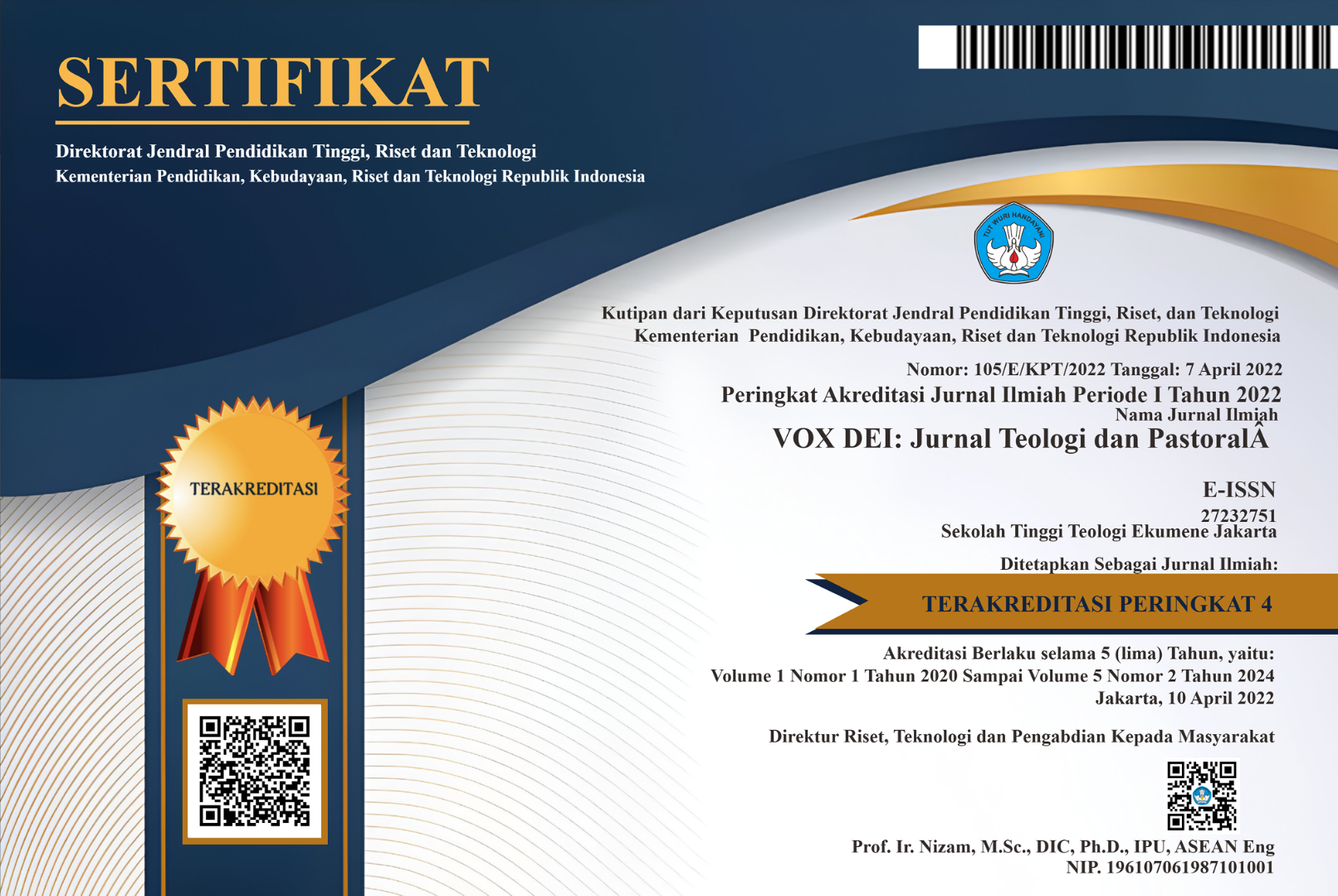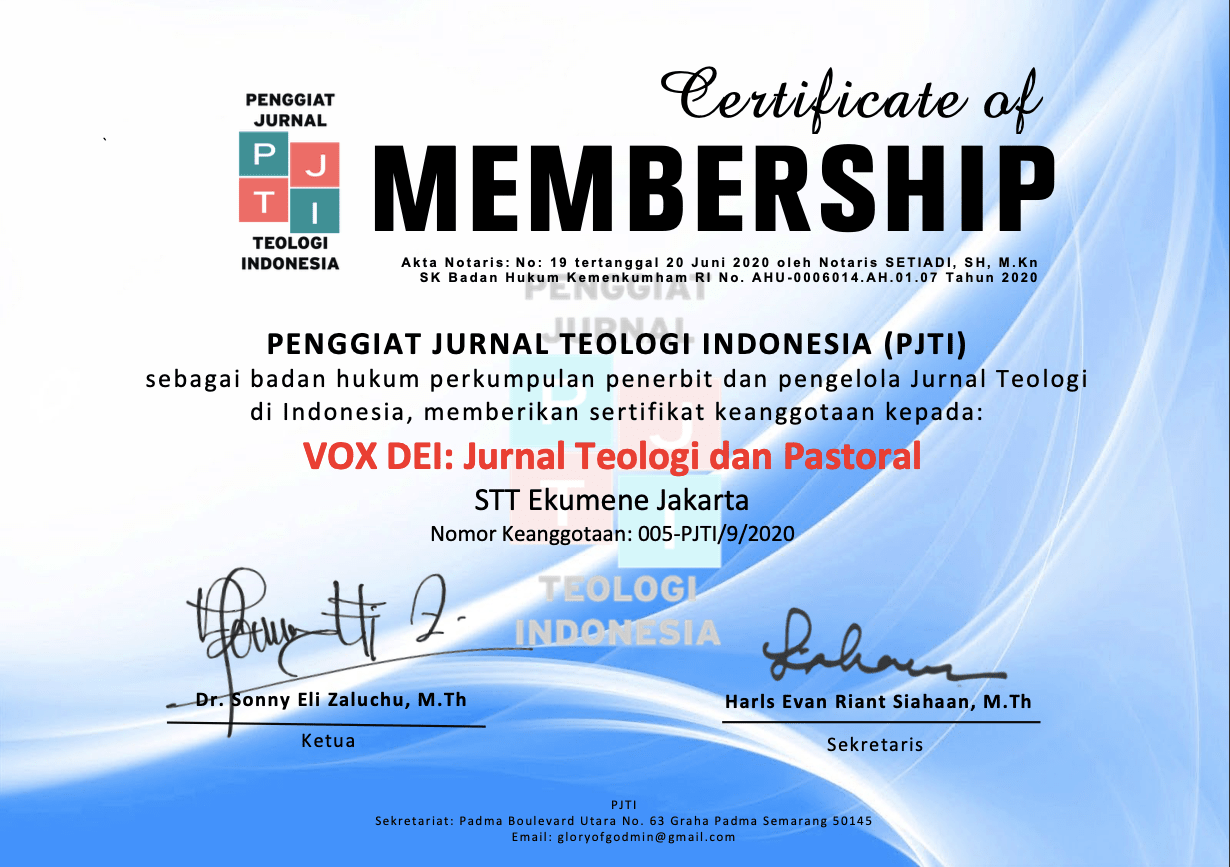PERSYARATAN SUKSESOR GEREJA SUARA KEBENARAN INJIL
DOI:
https://doi.org/10.46408/vxd.v1i1.8Keywords:
church; Gereja Suara Kebenaran Injil; Old Testament; successor; JoshuaAbstract
Succession in an organization cannot be separated from certain requirements of a successor that is expected to be in line with the organization's vision, mission, and values. Therefore, Gereja Suara Kebenaran Injil (GSKI) as an organization must have a description of the successor's accommodative requirements in realizing the interests of the organization in the future. This paper aims to describe the successor requirements that are accommodating to the needs of the GSKI organization in the future based on field findings and a biblical study of Joshua as a successful successor model. The requirements found were proposed as a constructive recommendation for the standard and accommodating successor requirements within the GSKI body. This research uses a qualitative method with a grounded theory approach. Data collection techniques were carried out through interviews with stakeholders and literature studies. Data were analyzed by synthesizing the findings in the literature study and interviews. The synthesis between interview findings and literature study produced a conceptual framework regarding accommodative successor requirements. The analysis shows that the requirements of accommodative GSKI successors are those who have a healthy and consistent spirituality, educated teachers, pastors who are skilled in pastoral care, accomplished organizers and person who has the vision to improve organizational quality collectively. This research concludes that the requirements of the GSKI successors in the future are deeply intersected with the quality of the present GSKI leader. Achieving this is greatly influenced by an effective mentoring and empowerment process.
Downloads
References
Berlinger, L. R. (2003). 91 the behavioral competency approach to effective ecclesial leadership 1 lisa r. berlinger, 2(2), 91–113.
Byers, L., & Byers, L. (2016). Succession Planning Strategies of Faith-Based , Nonprofit Leaders of the Boomer Generation This is to certify that the doctoral study by, (April). https://doi.org/10.13140/RG.2.1.3171.1608
Child, B. S. (1979). Introduction to The Old Testament as A Scripture.
Gordon, P. A., & Overbey, J. A. (2018). Succession planning: Promoting organizational sustainability. Succession Planning: Promoting Organizational Sustainability, (June), 1–242. https://doi.org/10.1007/978-3-319-72532-1
Gowthami, C. (2012). Succession Planning a Need or a Necessity – a Global Perspective. International Journal of Management, IT and Engineering, 2(9), 341–352. Diambil dari http://www.ijmra.us/project doc/IJMIE_SEPTEMBER2012/IJMRA-MIE1756.pdf
Groves, K. S. (2007). Integrating leadership development and succession planning best practices. Journal of Management Development, 26(3), 239–260. https://doi.org/10.1108/02621710710732146
Ishola, S. A., & Wojuola, K. T. (2019). Jethro-Moses Model of Leadership : A Lesson for Effective Leadership in Church and Secular Organizations, (6), 42–47.
KBBI. (2020). Kamus Besar Bahasa Indonesia.
Maxwell, J. C. (2013). 21 Hukum Kepemimpinan Sejati. Jakarta: Immanuel.
Maxwell, J. C. (2014). The Indispensable Qualities of A Leader: 21 Ciri Pokok Seorang Pemimpin. (E. M. Tanuadji, Ed.). Surabaya: PT MIC.
Mehrabani, S. (2013). Succession Planning: A Necessary Process in Today’s Organization. International Journal of e-Education, e-Business, e-Management and e-Learning, 1(5). https://doi.org/10.7763/ijeeee.2011.v1.61
Nullens, P. (2013). Towards a spirituality of public leadership: Engaging dietrich bonhoefffer. International Journal of Public Theology, 7(1), 91–113. https://doi.org/10.1163/15697320-12341268
Oluwaseun Oduwusi, O. (2018). Succession Planning as a Key to Effective Managerial Transition Process in Corporate Organizations. American Journal of Management Science and Engineering, 3(1), 1. https://doi.org/10.11648/j.ajmse.20180301.11
Parapat, Y., Sabdono, E., Andreas, M., & Wurjanto, A. (2020). Moses Leadership Transition - A Moses Leadership Transition Model - A Successful Succession Management Model, 5(4).
Pongtiku, A. (2019). Grounded Theory: Step by Step. In Metode Penelitian: Tradisi Kualitatif. Jakarta: In Media.
Ramsey, G. W. (1992). Joshua (Person). In The Anchor Yale Bible Dictionary. Doubleday.
Sanders, J. O. (2007). Spiritual Leadership. Chicago.
Santora, J. C., Sarros, J. C., & Esposito, M. (2013). Nonprofit founders and succession: How to ensure an effective leadership handover. Development and Learning in Organizations, 28(1), 16–19. https://doi.org/10.1108/DLO-09-2013-0072
Susan, K. (2009). Core Competencies of Large Church Leadership, (1).
Toliver, Y. (2017). Succession Planning for Next Generation Business Leaders, 131. Diambil dari https://scholarworks.waldenu.edu/dissertations
Younger, K. L. J. (2000). Joshua. In Eerdmans Dictionary of the Bible. W.B. Eerdmans.
Yukl, G. (2012). Effective leadership behavior: What we know and what questions need more attention. Academy of Management Perspectives, 26(4), 66–85. https://doi.org/10.5465/amp.2012.0088
















